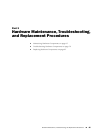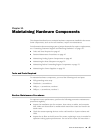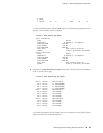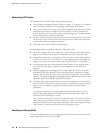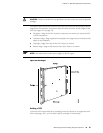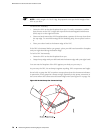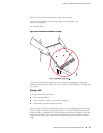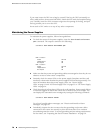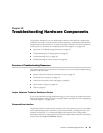
user@host> show chassis environment cb 0
CB 0 status:
State Online
Temperature Intake 66 degrees C / 150 degrees F
Temperature Exhaust A 67 degrees C / 152 degrees F
Temperature Exhaust B 73 degrees C / 163 degrees F
Power
1.2 V 1153 mV
1.5 V 1417 mV
1.8 V 1704 mV
2.5 V 2375 mV
3.3 V 3138 mV
5.0 V 4763 mV
1.2 V Rocket IO 1160 mV
1.5 V Rocket IO 1408 mV
1.8 V RLDRAM 1717 mV
I2C Slave Revision 15
For more information about using the CLI, see the JUNOS software manuals.
Maintaining Packet Forwarding Engine Components
For instructions on maintaining Packet Forwarding Engine components, see the
following sections:
■ Maintaining DPCs on page 72
■ Maintaining DPC Cables on page 74
■ Handling and Storing DPCs on page 74
Maintaining DPCs
The router can have up to three Dense Port Concentrators (DPCs) mounted
horizontally in the DPC card cage at the front of the chassis, as shown in
Figure 1 on page 6. To maintain DPCs, perform the following procedures regularly:
■ Check the LEDs on the craft interface directly above each DPC slot. The green
LED labeled OK lights steadily when a DPC is functioning normally. For more
information, see “DPC LEDs” on page 20.
■
Check the OK/FAIL LED on the DPC. For more information, see Table 7 on page
10 and Table 8 on page 10. If the DPC detects a failure, the DPC sends an alarm
message to the Routing Engine.
■
Issue the CLI show chassis fpc command to check the status of installed DPCs.
As shown in the sample output, the value Online in the column labeled State
indicates that the DPC is functioning normally:
user@host> show chassis fpc
Temp CPU Utilization (%) Memory Utilization (%)
Slot State (C) Total Interrupt DRAM (MB) Heap Buffer
0 Online 41 9 0 1024 15 57
1 Online 43 5 0 1024 16 57
2 Online 43 11 0 1024 16 57
72 ■ Maintaining Packet Forwarding Engine Components
MX240 Ethernet Services Router Hardware Guide




